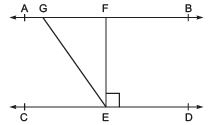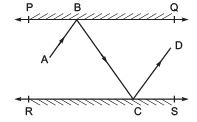NCERT Solutions for Class 9 Maths Chapter 6 - Lines and Angles (Exercise 6.2)
Q1. In the following Figure, if AB CD, CD EF and y : z = 3 : 7, find x.
Ans: It is known that ABCD and CDEF
Angles on the same side of a transversal are supplementary: x + y = 180°.
Corresponding angles are equal, so angle O = z.
Linear pair: y + O = 180° implies y + z = 180°.
Now, let y = 3w and hence, z = 7w (As y : z = 3 : 7)
∴ 3w+7w = 180°
Or, 10 w = 180°
So, w = 18°
Now, y = 3×18° = 54°
and, z = 7×18° = 126°
Now, angle x can be calculated from equation (i)
x+y = 180°
Or, x+54° = 180°
∴ x = 126°
Q2. In the following figure, if AB || CD, EF ⊥ CD and ∠GED = 126°, find ∠AGE, ∠GEF and ∠FGE. Ans: Since AB || CD, GE is a transversal.
Ans: Since AB || CD, GE is a transversal.
It is given that ∠GED = 126°
So, ∠GED = ∠AGE = 126° (As they are alternate interior angles)
Also,
∠GED = ∠GEF +∠FED
As EF⊥ CD, ∠FED = 90°
∴ ∠GED = ∠GEF+90°
Or, ∠GEF = 126° – 90° = 36°
Again, ∠FGE +∠GED = 180° (Transversal)
Putting the value of ∠GED = 126°, we get
∠FGE = 54°
So,
∠AGE = 126°
∠GEF = 36° and
∠FGE = 54°
Q3. In the following figure, if PQ || ST, ∠PQR = 110° and ∠RST = 130°, find ∠QRS.
[Hint : Draw a line parallel to ST through point R.]
Ans: First, construct a line XY parallel to PQ.
We know that the angles on the same side of transversal is equal to 180°.
So, ∠PQR+∠QRX = 180°
Or, ∠QRX = 180°-110°
∴ ∠QRX = 70°
Similarly,
∠RST +∠SRY = 180°
Or, ∠SRY = 180°- 130°
∴ ∠SRY = 50°
Now, for the linear pairs on the line XY-
∠QRX+∠QRS+∠SRY = 180°
Putting their respective values, we get
∠QRS = 180° – 70° – 50°
Hence, ∠QRS = 60°
Q4. In the following figure, if AB || CD, ∠ APQ = 50° and ∠ PRD = 127°, find x and y Ans: From the diagram,
Ans: From the diagram,
∠APQ = ∠PQR (Alternate interior angles)
Now, putting the value of ∠APQ = 50° and ∠PQR = x, we get
x = 50°
Also,
∠APR = ∠PRD (Alternate interior angles)
Or, ∠APR = 127° (As it is given that ∠PRD = 127°)
We know that
∠APR = ∠APQ+∠QPR
Now, putting values of ∠QPR = y and ∠APR = 127°, we get
127° = 50°+ y
Or, y = 77°
Thus, the values of x and y are calculated as:
x = 50° and y = 77°
Q5. In the following figure, PQ and RS are two mirrors placed parallel to each other. An incident ray AB strikes the mirror PQ at B, the reflected ray moves along the path BC and strikes the mirror RS at C and again reflects back along CD. Prove that AB || CD.
Ans: First, draw two lines, BE and CF, such that BE ⊥ PQ and CF ⊥ RS.
Now, since PQ || RS,
So, BE || CF
We know that,
The angle of incidence = The angle of reflection (By the law of reflection)
So,
∠1 = ∠2 and
∠3 = ∠4
We also know that alternate interior angles are equal. Here, BE ⊥ CF and the transversal line BC cuts them at B and C
So, ∠2 = ∠3 (As they are alternate interior angles)
Now, ∠1 +∠2 = ∠3 +∠4
Or, ∠ABC = ∠DCB
So, AB || CD (alternate interior angles are equal)
|
276 docs|155 tests
|
FAQs on NCERT Solutions for Class 9 Maths Chapter 6 - Lines and Angles (Exercise 6.2)
| 1. What are the basic concepts of lines and angles covered in Exercise 6.2 of NCERT? |  |
| 2. How do you identify complementary and supplementary angles in the context of Exercise 6.2? |  |
| 3. What is the importance of parallel lines in understanding angles as per the NCERT Exercise 6.2? |  |
| 4. How can I solve the problems in Exercise 6.2 efficiently? |  |
| 5. Can you explain how to prove that two angles are complementary using Exercise 6.2? |  |

















